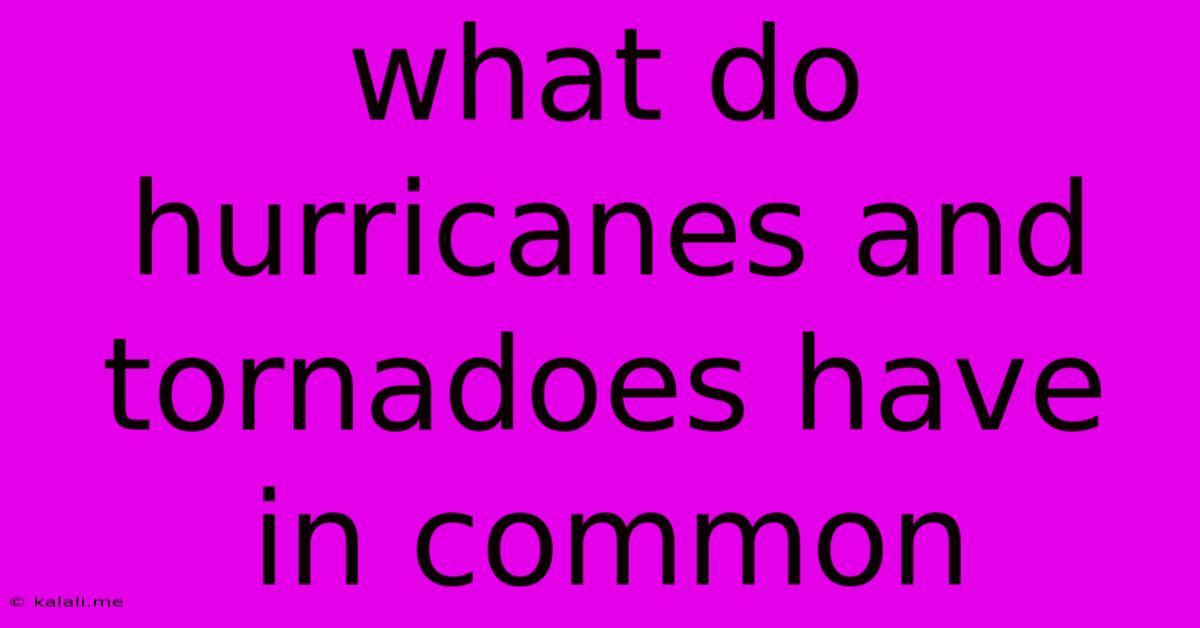What Do Hurricanes And Tornadoes Have In Common
Kalali
May 10, 2025 · 3 min read

Table of Contents
What Do Hurricanes and Tornadoes Have in Common? Understanding the Similarities Between These Violent Storms
Hurricanes and tornadoes, both terrifying displays of nature's power, often dominate news headlines during storm season. While drastically different in appearance and formation, these extreme weather events share some surprising similarities. This article delves into the commonalities between hurricanes and tornadoes, exploring their fundamental physics and the devastating impact they have. Understanding these shared characteristics helps us better prepare for and mitigate the risks associated with these powerful storms.
Shared Origins: Atmospheric Instability and Moisture
At their core, both hurricanes and tornadoes are fueled by atmospheric instability and abundant atmospheric moisture. This instability creates an environment where warm, moist air rises rapidly, leading to powerful updrafts. This rising air cools and condenses, releasing latent heat – energy stored within water vapor – which further fuels the storm's intensity. The amount of moisture available significantly impacts the strength and longevity of both types of storms. A lack of moisture will quickly weaken both a hurricane and a tornado.
The Role of Rotation: Cyclonic Circulation
While their scales differ dramatically, both hurricanes and tornadoes exhibit cyclonic circulation, meaning they rotate. This rotation is caused by the Coriolis effect, a phenomenon arising from the Earth's rotation. The Coriolis effect causes moving air to be deflected to the right in the Northern Hemisphere and to the left in the Southern Hemisphere. This deflection, combined with other atmospheric forces, creates the characteristic spin of both hurricanes (large-scale rotation) and tornadoes (smaller, more intense rotation). The strength of the rotation is crucial in determining the intensity of the resulting storm.
Destructive Power: Wind and Pressure Changes
Both hurricanes and tornadoes are infamous for their devastating winds, capable of causing widespread damage. These high-speed winds are a direct consequence of the intense pressure gradients within the storms. The pressure difference between the storm's center and the surrounding environment drives powerful winds towards the lower pressure zone. Furthermore, both can cause significant pressure drops, leading to structural damage due to the sudden pressure differential. The combination of high winds and pressure fluctuations causes considerable destruction to buildings, infrastructure, and vegetation.
Formation Triggered by Other Weather Systems: A Confluence of Factors
While their formation processes are distinct, both hurricanes and tornadoes often develop within or in association with larger weather systems. Hurricanes, for example, typically form over warm ocean waters and are often influenced by pre-existing tropical waves or disturbances. Tornadoes frequently form within supercell thunderstorms, powerful rotating thunderstorms characterized by strong updrafts and downdrafts. This highlights the interplay of various atmospheric conditions required for the genesis and intensification of these phenomena. Understanding these pre-cursors is crucial for effective forecasting.
Predicting the Unpredictable: Forecasting Challenges
Predicting the exact path and intensity of both hurricanes and tornadoes remains a significant challenge for meteorologists. While advancements in weather forecasting technology have improved prediction accuracy, the inherent complexity of the atmospheric processes involved makes precise forecasting difficult, especially at short lead times. Continuous research and technological advancements are crucial for enhancing forecasting capabilities and improving preparedness efforts.
In conclusion, despite their significant differences in scale and formation, hurricanes and tornadoes share crucial commonalities rooted in atmospheric instability, moisture, rotation, and the destructive power of high winds and pressure changes. Recognizing these similarities deepens our understanding of these extreme weather events, allowing for improved preparedness and risk mitigation strategies.
Latest Posts
Latest Posts
-
If Your 31 What Year Were You Born
Jul 15, 2025
-
How Many Tenths Are In An Inch
Jul 15, 2025
-
Which Word Has The Most Positive Connotation
Jul 15, 2025
-
How Do I Send An Evite Reminder
Jul 15, 2025
-
When Performing A Self Rescue When Should You Swim To Shore
Jul 15, 2025
Related Post
Thank you for visiting our website which covers about What Do Hurricanes And Tornadoes Have In Common . We hope the information provided has been useful to you. Feel free to contact us if you have any questions or need further assistance. See you next time and don't miss to bookmark.